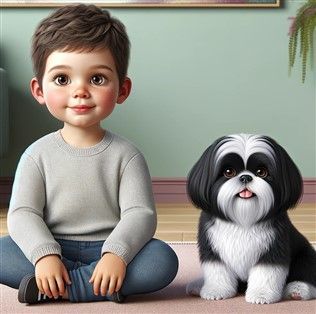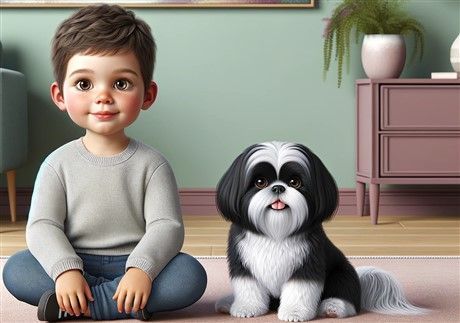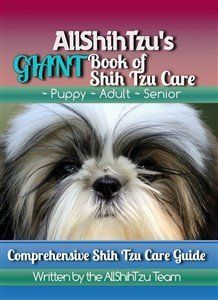Shih Tzu and Children
Overview
- Shih Tzu Dogs and Children: Compatibility and Behavior
- Harmonious Living: Integrating Shih Tzu Dogs and Children in Your Home
- 6 Safety Tips for Children and Shih Tzu Interaction
- Managing a Child and a Teething Puppy
- Managing a New Baby and a Shih Tzu


Shih Tzu Dogs and Children: Poll Results
In 2017, we at AllShihTzu conducted a survey with 2,749 Shih Tzu owners about their pets' personalities, traits, quirks and more. Among the respondents, 68% were from the US, 13% from the UK, 7% from Canada, with the rest hailing from various countries around the world.
The number of male to female Shih Tzu were almost equal, with just slightly more males (54%) than females (46%). The ages of the Shih Tzu were 40% young adult (1 to 3-years-old), 34% adult (4 to 8-years-old), 13% puppy (under 1-year-old), and 12% senior (9+ years).
We asked: How does your Shih Tzu get along with children? The results revealed:
- 74% of Shih Tzu dogs had interactions with children and were reported to get along ‘well’
- 14% did not encounter children enough for their pet parents to say
- 8% ignored children
- 4% did not get along well with children (110 Shih Tzu out of 2,749)
So, it’s clear that this breed generally does very well with youngsters.
Shih Tzu Dogs and Children: Compatibility and Behavior
Compatibility with Children in General: Shih Tzu dogs are renowned for their friendly and affectionate nature, making them ideal pets for families with children. Known for their gentleness and patience, they generally interact well with kids.
Behavior with Household Children: With children in their own household, Shih Tzu dogs often form strong bonds and exhibit nurturing and protective behaviors. They are usually more relaxed and engaging with familiar young family members.
Interactions with Unknown Children: When encountering children they don't know, a Shih Tzu may initially show cautiousness or hesitation. Supervised interactions are essential until your little guy or gal becomes comfortable around new children.
Puppy vs. Adult Shih Tzu Reactions:
- Puppy Behavior: Shih Tzu puppies are playful and energetic, which can lead to more exuberant interactions with children. However, their lack of awareness of their strength necessitates careful supervision.
- Adult Shih Tzu Behavior: Adult Shih Tzu dogs, usually more mature and calm, tend to have a more predictable and gentle approach to both known and unknown children.
Importance of Socialization and Training: Early socialization and consistent training are important. This helps a Shih Tzu puppy develop into an adult dog that safely and positively interacts with both familiar and unfamiliar children. Proper upbringing ensures that their inherent friendly nature is nurtured for the best interactions with children.
Harmonious Living: Integrating Shih Tzu Dogs and Children in Your Home
Following some guidelines can help create a positive environment between a Shih Tzu and a child.
- Early Socialization: Introduce your Shih Tzu to children as early as possible to develop their comfort and familiarity with young companions. This can be done through controlled play dates or visits, ensuring the interactions are positive and not overwhelming for the dog.
- Teach Respectful Interaction: Educate children on how to gently interact with the dog, emphasizing the importance of not engaging in rough play, such as pulling the dog’s coat, ears, or tail. It's crucial to teach children to recognize and respect the dog's personal space and boundaries.
- Supervised Playtime:
Always supervise interactions between your Shih Tzu and children, especially during playtime, to monitor for signs of stress or aggression. This oversight ensures that both the dog and the children are safe and that play remains gentle and appropriate.
- Safe Spaces: Provide a designated quiet area where your Shih Tzu can retreat when they need a break or feel overwhelmed. This space should be off-limits to children, ensuring the dog has a sanctuary for relaxation and stress relief. Using a canine playpen or gate can work well for this.
- Consistent Training: Regularly train your Shih Tzu with commands such as ‘sit’, ‘stay’, and ‘come’ to ensure they behave well around children. Older children should be a part of this training. Knowing commands helps in managing the Shih Tzu's behavior and reinforces obedience and discipline.
- Positive Reinforcement: Encourage good behavior in both your Shih Tzu and the children by using positive reinforcement techniques. This can include special treats for your Shih Tzu when they behave well around children and praise for children when they interact appropriately with the dog.
- Family Involvement: Involve children in the care routine of the Shih Tzu, such as feeding, grooming, and walking under supervision. This not only helps in building a strong bond between them but also teaches children responsibility and empathy towards animals.
6 Safety Tips for Children and Shih Tzu Interaction


Please remind children of some simple rules that will keep your Shih Tzu safe:
- Show your child how to pick up a Shih Tzu puppy: Approach from the side, kneeling down to cradle the pup, one hand on the rump, the other gently yet firmly holding the tummy /chest area.
- A child should not run, spin or jump, when holding a Shih Tzu and should not swing them around.
- Never point a finger at or poke at the Shih Tzu. Remind your child how tender the nose and eyes are. Teach that “tail pulling” must not be done.
- Supervise grooming. There is no reason why a youngster cannot be part of grooming care, especially brushing the coat and helping to give baths; however, please do teach the steps of proper grooming techniques. As your child grows, you will have a helper who can take over these tasks.
- Explain food rules. Children should not give any of their own food to the Shih Tzu, as some human foods are toxic to canines.
- Explain what an under-the-foot dog is. Have your children (or any visiting children) be very aware that the Shih Tzu is an “under-the-foot” dog, meaning that he is small and quick…. This breed can go from being across the room to being underfoot in the blink of an eye, where young children can trip over or accidentally step on the dog.
Managing a Child and a Teething Puppy
Teething puppies, with their intense need to chew, can present a uniquely challenging situation. To navigate this phase effectively, here are some essential tips:
- Safe Chew Toys: Provide the puppy with plenty of safe chew toys. This not only soothes their gums but also keeps them from chewing on inappropriate items, including children's toys.
- Teach Gentle Play: Educate your child on how to play gently with the puppy. Explain that the puppy is going through a phase where its gums are sore and might react unexpectedly.
- Supervised Interactions: Always supervise interactions between your child and the teething puppy. This helps in preventing any accidental rough play or biting.
- Give the Puppy a Separate Area: If the puppy is nipping, keep them in a designated area if you cannot closely supervise. Indoor gates or a canine playpen can help with this.
By following these tips, you can help ensure a safe and positive environment for both your child and your teething puppy. The key is to promote understanding, patience, and appropriate play behaviors, fostering a harmonious relationship between the two.
Managing a New Baby and a Shih Tzu
If you will be welcoming a new baby into your family and you have an established Shih Tzu, there is some planning to do and some guidelines to follow:
- Early Household Changes: Before the baby arrives, rearrange furniture and introduce baby items, teaching your Shih Tzu that these are off-limits. This preparation sets clear boundaries.
- Familiarizing with Baby Scents: Introduce your Shih Tzu to the baby's scent by placing some of the baby lotion you plan to use for your baby onto washcloths and placing them in common areas. This will help your Shih Tzu adjust to the new scent.
- Desensitizing to Baby Sounds: Use recordings of baby noises to acclimate your little guy or gal to these new sounds, starting softly and gradually increasing the volume. This reduces potential anxiety or surprise.
- Consistent Routine: Keep your Shih Tzu’s routine as consistent as possible. Regular walks, feeding, and playtime provide stability amidst household changes.
- Supervised First Meetings: Ensure initial interactions between your Shih Tzu and the baby are supervised, looking out for signs of stress or jealousy in your Shih Tzu.
- Positive Reinforcement: Reward calm and gentle behavior around the baby to encourage positive associations.
- Separate Attention: Continue to give your Shih Tzu individual attention to prevent feelings of neglect.
By following these steps, you can help create a positive environment for both your Shih Tzu and your new baby, fostering a lasting bond. Patience and consistent reinforcement are key during this transition.
Are You an AllShihTzu Member?
Take a quick moment to become an AllShihTzu Member; It's completely free. You'll receive a Welcome Booklet and our friendly newsletters. You'll also be able to suggest a topic for us to write about. It's the best way for us to stay in touch, so we hope you'll join us today.

